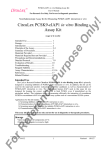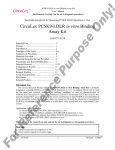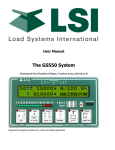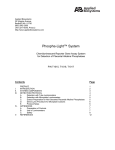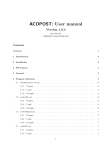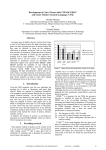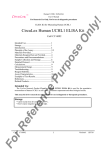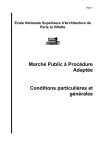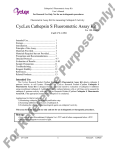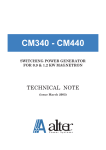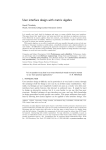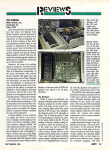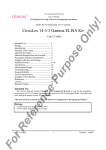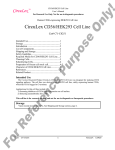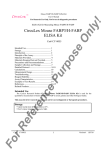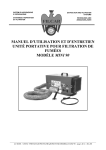Download CircuLex TM CircuLex TM
Transcript
t. uc od pr Human PCSK9 ELISA Kit User’s Manual For Research Use Only, Not for use in diagnostic procedures ur CircuLex TM ith yo ELISA Kit for Measuring Human PCSK9 ew CircuLex Human PCSK9 ELISA Kit ca at th al an u rm se re fe rt o th eu Intended Use................................................ 1 Storage......................................................... 1 Introduction.................................................. 2 Principle of the Assay.................................. 2-3 Materials Provided....................................... 3 Materials Required but not Provided........... 4 Precautions and Recommendations............. 5 Sample Collection and Storage.....................6 Detailed Protocol......................................... 7-8 Calculations.................................…............ 9 Measurement Range.................................... 9 Troubleshooting.......................................... 9 Reagent Stability......................................... 10 Assay Characteristics.................................. 10-13 Example of Test Results..............................14-16 References................................................... 17 Related Products......................................... 18 m Cat# CY-8079 Intended Use ea se The CycLex Research Product CircuLex Human PCSK9 ELISA Kit is used for the quantitative measurement of Human PCSK9 in serum, plasma, cell culture medium and other biological media. Pl This assay kit is for research use only and not for use in diagnostic or therapeutic procedures. nl y! Storage er en ce Pu rp os eO • Upon receipt store all components at 4°C. • Don’t expose reagents to excessive light. Fo rR ef Cat#: CY-8079 1 Version#: 151105 t. uc od pr Human PCSK9 ELISA Kit User’s Manual For Research Use Only, Not for use in diagnostic procedures yo ur CircuLex TM ith Introduction eu se rm an u al th at ca m ew PCSK9 (also known as neural apoptosis-regulated convertase, NARC-1) is a 692-residue extracellular protein expressed primarily in the kidneys, liver and intestines (1) representing the 9th member of the secretory subtilase family. Various genetic observations subsequently mapped PCSK9 as the third gene (along with LDLR and APOB) to cause autosomal dominant hypercholesterolemia (ADH). These studies suggested that gain of function mutations increase plasma levels of LDL-c (2–6), whereas nonsense or missense (loss-of-function) mutations, which interfere with folding or secretion of PCSK9, lead to a reduction of plasma levels of LDL-c and an 88% decrease in the risk of coronary heart disease (CHD) (5). In mice, adenoviral overexpression of PCSK9 results in increased plasma LDL-c level in normal mice but not in LDLR-deficient mice (7). Deletion of PCSK9 causes an increase in level of LDLR protein but not mRNA (8). These findings lead to a hypothesis that PCSK9 exerts its role in cholesterol metabolism through posttranslational down-regulation of LDLR, the receptor responsible for clearing LDL-c from plasma. Evidence is consistent with the secreted form of PCSK9 binding directly to the LDLR and resulting in degradation of the receptor (9, 10). Zhang et al. (11) localized the binding site of PCSK9 in the LDLR to the first epidermal growth factor-like repeat (EGF-A) of the extracellular domain and showed that PCSK9 binding to this site is required for LDLR degradation. In light of these observations and the fact that PCSK9 in the circulation may cause the degradation of hepatic LDLR in the liver, PCSK9 would seem to be an attractive drug target for lowering LDL-c. th Principle of the Assay er en ce Pu rp os eO nl y! Pl ea se re fe rt o The CircuLex Human PCSK9 ELISA Kit employs the quantitative sandwich enzyme immunoassay technique. An antibody specific for PCSK9 has been pre-coated onto a microplate. Standards and samples are pipetted into the wells and the immobilized antibody binds any PCSK9 present. After washing away any unbound substances, an HRP conjugated monoclonal antibody specific for PCSK9 is added to the wells. Following a wash to remove any unbound antibody HRP conjugate, the remaining conjugate is allowed to react with the substrate H2O2-tetramethylbenzidine. The reaction is stopped by addition of acidic solution and absorbance of the resulting yellow product is measured at 450 nm. The absorbance is proportional to the concentration of PCSK9. A standard curve is constructed by plotting absorbance values versus PCSK9 concentrations of calibrators, and concentrations of unknown samples are determined using this standard curve. The CircuLex Human PCSK9 ELISA Kit is designed to measure the concentration of Human PCSK9 from human serum/plasma or conditioned medium. Fo rR ef Cat#: CY-8079 2 Version#: 151105 t. uc od pr Human PCSK9 ELISA Kit User’s Manual For Research Use Only, Not for use in diagnostic procedures yo ur CircuLex TM ith Summary of Procedure ew Add 100 µL of diluted sample to the wells Incubate for 1 hour at room temp. ca m Wash the wells at Add 100 µL of HRP conjugated anti-PCSK9 monoclonal antibody th Incubate for 1hour at room temp. an u al Wash the wells Add 100 µL of Substrate Reagent rm Incubate for 10 to 20 minutes at room temp. th eu Measure absorbance at 450 nm se Add 100 µL of Stop Solution o Materials Provided fe rt All samples and standards should be assayed in duplicate. The following components are supplied and are sufficient for the one 96-well microplate kit. se re Microplate: One microplate supplied ready to use, with 96 wells (12 strips of 8-wells) in a foil, zip-lock bag with a desiccant pack. Wells are coated with anti-PCSK9 antibody as a capture antibody. ea 10X Wash Buffer: One 100 mL bottle of 10X buffer containing Tween®-20 Pl Dilution Buffer: One bottle containing 50 mL of 1X buffer; use for sample dilution. Ready to use. nl y! PCSK9 Standard: One vial containing 50 ng of lyophilized recombinant human PCSK9 eO HRP conjugated Detection Antibody: One vial containing 12 mL of HRP (horseradish peroxidase) conjugated anti-PCSK9 monoclonal antibody (KS-2C10). Ready to use. Pu rp os Substrate Reagent: One bottle containing 20 mL of the chromogenic substrate, tetra-methylbenzidine (TMB). Ready to use. er en ce Stop Solution: One bottle containing 20 mL of 1 N H2SO4. Ready to use. Fo rR ef Cat#: CY-8079 3 Version#: 151105 t. uc od pr Human PCSK9 ELISA Kit User’s Manual For Research Use Only, Not for use in diagnostic procedures yo ur CircuLex TM ew • Pipettors: 2-20 µL, 20-200 µL and 200-1000 µL precision pipettors with disposable tips. ith Materials Required but not Provided • Precision repeating pipettor ca m • Orbital microplate shaker at • Microcentrifuge and tubes for sample preparation. th • Vortex mixer al • (Optional) Microplate washer: Manual washing is possible but not preferable. rm an u • Plate reader capable of measuring absorbance in 96-well plates at dual wavelengths of 450 nm/540 nm. Dual wavelengths of 450/550 or 450/595 nm can also be used. The plate can also be read at a single wavelength of 450 nm, which will give a somewhat higher reading. se • (Optional) Software package facilitating data generation and analysis eu • 500 or 1000 mL graduated cylinder. th • Reagent reservoirs o • Deionized water of the highest quality er en ce Pu rp os eO nl y! Pl ea se re fe rt • Disposable paper towels Fo rR ef Cat#: CY-8079 4 Version#: 151105 t. uc od pr Human PCSK9 ELISA Kit User’s Manual For Research Use Only, Not for use in diagnostic procedures yo ur CircuLex TM ith Precautions and Recommendations ew • Allow all the components to come to room temperature before use. m • All microplate strips that are not immediately required should be returned to the zip-lock pouch, which must be carefully resealed to avoid moisture absorption. ca • Do not use kit components beyond the indicated kit expiration date. th at • Use only the microtiter wells provided with the kit. al • Rinse all detergent residue from glassware. an u • Use deionized water of the highest quality. rm • Do not mix reagents from different kits. eu • Do not mouth pipette or ingest any of the reagents. se • The buffers and reagents in this kit may contain preservatives or other chemicals. Care should be taken to avoid direct contact with these reagents. o th • Do not smoke, eat, or drink when performing the assay or in areas where samples or reagents are handled. rt • Dispose of tetra-methylbenzidine (TMB) containing solutions in compliance with local regulations. re fe • Avoid contact with the acidic Stop Solution and Substrate Solution, which contains hydrogen peroxide. ea se • Wear gloves and eye protection when handling immunodiagnostic materials and samples of human origin, and these reagents. In case of contact with the Stop Solution and the Substrate Solution, wash skin thoroughly with water and seek medical attention, when necessary. nl y! Pl • Biological samples may be contaminated with infectious agents. Do not ingest, expose to open wounds or breathe aerosols. Wear protective gloves and dispose of biological samples properly. er en ce Pu rp os eO • CAUTION: Sulfuric Acid is a strong acid. Wear disposable gloves and eye protection when handling Stop Solution. Fo rR ef Cat#: CY-8079 5 Version#: 151105 t. uc od pr Human PCSK9 ELISA Kit User’s Manual For Research Use Only, Not for use in diagnostic procedures yo ur CircuLex TM ith Sample Collection and Storage m ew Serum: Use a serum separator tube and allow samples to clot for 60 ± 30 minutes. Centrifuge the samples at 4°C for 10 minutes at 1,000 x g. Remove serum and assay immediately or store samples on ice for up to 6 hours before assaying. Aliquots of serum may also be stored at below -70°C for extended periods of time. Avoid repeated freeze-thaw cycles. an u Note: Citrate plasma has not been validated for use in this assay. al th at ca Plasma: Collect plasma using EDTA-Na2 as the anticoagulant. If possible, collect the plasma into a mixture of EDTA-Na2 and Futhan5 to stabilize the sample against spontaneous in vitro complement activation. Immediately centrifuge samples at 4°C for 15 minutes at 1,000 x g. Assay immediately or store samples on ice for up to 6 hours before assaying. Aliquots of plasma may also be stored at below -70°C for extended periods of time. Avoid repeated freeze-thaw cycles. er en ce Pu rp os eO nl y! Pl ea se re fe rt o th eu se rm Other biological samples: Remove any particulates by centrifugation and assay immediately or aliquot and store samples at below -70°C. Avoid repeated freeze-thaw cycles. Fo rR ef Cat#: CY-8079 6 Version#: 151105 t. uc od pr Human PCSK9 ELISA Kit User’s Manual For Research Use Only, Not for use in diagnostic procedures yo ur CircuLex TM ith Detailed Protocol ca m ew The CycLex Research Product CircuLex Human PCSK9 ELISA Kit is provided with removable strips of wells so the assay can be carried out on separate occasions using only the number of strips required for the particular determination. Since experimental conditions may vary, an aliquot of the PCSK9 Standard within the kit, should be included in each assay as a calibrator. Disposable pipette tips and reagent troughs should be used for all liquid transfers to avoid cross-contamination of reagents or samples. at Preparation of Working Solutions al th All reagents need to be brought to room temperature prior to the assay. Assay reagents are supplied ready-to-use, with the exception of 10X Wash Buffer and PCSK9 Standard. rm an u 1. Prepare a working solution of Wash Buffer by adding 100 mL of the 10X Wash Buffer to 900 mL of deionized (distilled) water (ddH2O). Mix well. Store at 4°C for two weeks or -20°C for long-term storage. se 2. Reconstitute PCSK9 Standard with 0.5 mL of ddH2O. The concentration of the human PCSK9 in vial should be 100 ng/mL, which is referred as a Master Standard of human PCSK9. o th eu Prepare Standard Solutions as follows: Use the Master Standard to produce a dilution series (below). Mix each tube thoroughly before the next transfer. The 10 ng/mL standard (Std.1) serves as the highest standard. The Dilution Buffer serves as the zero standard (Blank). Dilution Buffer 540 µL 300 µL 300 µL 300 µL 300 µL 300 µL 300 µL 300 µL rt Volume of Standard 60 µL of Master Standard 300 µL of Std. 1 (10 ng/ml) 300 µL of Std. 2 (5 ng/ml) 300 µL of Std. 3 (2.5 ng/ml) 300 µL of Std. 4 (1.25 ng/ml) 300 µL of Std. 5 (0.63 ng/ml) 300 µL of Std. 6 (0.31 ng/ml) nl y! Pl ea se re fe Std.1 Std.2 Std.3 Std.4 Std.5 Std.6 Std.7 Blank - Concentration 10 ng/mL 5 ng/mL 2.5 ng/mL 1.25 ng/mL 0.63 ng/mL 0.31 ng/mL 0.16 ng/mL 0 ng/mL os eO Note: Do not use a Repeating pipette. Change tips for every dilution. Wet tip with Dilution Buffer before dispensing. Unused portions of Master Standards should be aliquoted and stored at below -70°C immediately. Avoid multiple freeze and thaw cycles. Pu rp Sample Preparation • Serum and plasma samples may require a 100-fold dilution. e.g. 3 µL serum sample + 297 µL Dilution Buffer er en ce • Other biological samples require neat to appropriate dilution. Fo rR ef Cat#: CY-8079 7 Version#: 151105 t. uc od pr Human PCSK9 ELISA Kit User’s Manual For Research Use Only, Not for use in diagnostic procedures yo ur CircuLex TM Assay Procedure ew ith 1. Remove the appropriate number of microtiter wells from the foil pouch and place them into the well holder. Return any unused wells to the foil pouch, refold, seal with tape and store at 4°C. m 2. Dilute samples with Dilution Buffer. (See “Sample Preparation” above.) at ca 3. Pipette 100 µL of Standard Solutions (Std1-Std7, Blank) and diluted samples in duplicates, into the appropriate wells. th 4. Incubate the plate at room temperature (ca.25°C) for 1 hour, shaking at ca. 300 rpm on an orbital microplate shaker. an u al 5. Wash 4-times by filling each well with Wash Buffer (350 µL) using a squirt bottle, multi-channel pipette, manifold dispenser or microplate washer. rm 6. Add 100 µL of HRP conjugated Detection Antibody into each well. se 7. Incubate the plate at room temperature (ca.25°C) for 1 hour, shaking at ca. 300 rpm on an orbital microplate shaker. th eu 8. Wash 4-times by filling each well with Wash Buffer (350 µL) using a squirt bottle, multi-channel pipette, manifold dispenser or microplate washer. fe rt o 9. Add 100 µL of Substrate Reagent. Avoid exposing the microtiter plate to direct sunlight. Covering the plate with e.g. aluminum foil is recommended. Return Substrate Reagent to 4°C immediately after the necessary volume is removed se re 10. Incubate the plate at room temperature (ca.25°C) for 10-20 minutes, shaking at ca. 300 rpm on an orbital microplate shaker. The incubation time may be extended up to 30 minutes if the reaction temperature is below than 20°C. Pl ea 11. Add 100 µL of Stop Solution to each well in the same order as the previously added Substrate Reagent. eO nl y! 12. Measure absorbance in each well using a spectrophotometric microplate reader at dual wavelengths of 450/540 nm. Dual wavelengths of 450/550 or 450/595 nm can also be used. Read the microplate at 450 nm if only a single wavelength can be used. Wells must be read within 30 minutes of adding the Stop Solution. er en ce Pu rp os Note-1: Complete removal of liquid at each step is essential to good performance. After the last wash, remove any remaining Wash Buffer by aspirating or decanting. Invert the plate and blot it against clean paper towels. Note-2: Reliable standard curves are obtained when either O.D. values do not exceed 0.25 units for the blank (zero concentration), or 3.0 units for the highest standard concentration. The plate should be monitored at 5-minute intervals for approximately 30 minutes. Note-3: If the microplate reader is not capable of reading absorbance greater than the absorbance of the highest standard, perform a second reading at 405 nm. A new standard curve, constructed using the values measured at 405 nm, is used to determine PCSK9 concentration of off-scale samples. The readings at 405 nm should not replace the on-scale readings at 450 nm. Fo rR ef Cat#: CY-8079 8 Version#: 151105 t. uc od pr yo ur CircuLex Human PCSK9 ELISA Kit User’s Manual For Research Use Only, Not for use in diagnostic procedures TM ith Calculations at ca m ew Average the duplicate readings for each standard, control, and sample and subtract the average zero standard optical density. Plot the optical density for the standards versus the concentration of the standards and draw the best curve. The data can be linearized by using log/log paper and regression analysis may be applied to the log transformation. To determine the PCSK9 concentration of each sample, first find the absorbance value on the y-axis and extend a horizontal line to the standard curve. At the point of intersection, extend a vertical line to the x-axis and read the corresponding PCSK9 concentration. If the samples have been diluted, the concentration read from the standard curve must be multiplied by the dilution factor. an u al th 1. The dose-response curve of this assay fits best to a sigmoidal 5-parameter logistic equation. The results of unknown samples can be calculated with any computer program having a 5-parameter logistic function. It is important to make an appropriate mathematical adjustment to accommodate for the dilution factor. eu se rm 2. Most microtiter plate readers perform automatic calculations of analyte concentration. The calibration curve is constructed by plotting the absorbance (Y) of calibrators versus log of the known concentration (X) of calibrators, using the four-parameter function. Alternatively, the logit log function can be used to linearize the calibration curve (i.e. logit of absorbance (Y) is plotted versus log of the known concentration (X) of calibrators). th Measurement Range fe rt o The measurement range is 0.16 ng/mL to 10 ng/mL. Any sample reading higher than the highest standard should be diluted with Dilution Buffer in higher dilution and re-assayed. Dilution factors need to be taken into consideration in calculating the human PCSK9 concentration. re Troubleshooting Pl ea se 1. All samples and standards should be assayed in duplicate, using the protocol described in the Detailed Protocol. Incubation times or temperatures significantly different from those specified may give erroneous results. nl y! 2. Poor duplicates, accompanied by elevated values for wells containing no sample, indicate insufficient washing. If all instructions in the Detailed Protocol were followed accurately, such results indicate a need for washer maintenance. er en ce Pu rp os eO 3. Overall low signal may indicate that desiccation of the plate has occurred between the final wash and addition of Substrate Reagent. Do not allow the plate to dry out. Add Substrate Reagent immediately after wash. Fo rR ef Cat#: CY-8079 9 Version#: 151105 t. uc od yo ur CircuLex Human PCSK9 ELISA Kit User’s Manual For Research Use Only, Not for use in diagnostic procedures pr TM ith Reagent Stability ca m ew All of the reagents included in the CycLex Research Product CircuLex Human PCSK9 ELISA Kit have been tested for stability. Reagents should not be used beyond the stated expiration date. Upon receipt, kit reagents should be stored at 4°C, except the reconstituted PCSK9 Standard must be stored at below -70°C. Coated assay plates should be stored in the original foil bag sealed by the zip lock and containing a desiccant pack. at Assay Characteristics an u al th 1. Sensitivity The limit of detection (defined as such a concentration of PCSK9 giving absorbance higher than mean absorbance of blank* plus three standard deviations of the absorbance of blank: A blank + 3SD blank) is better than 0.154 ng/ml of sample. rm * Dilution Buffer was pipetted into blank wells. eu se Eighty assays were evaluated and the minimum detectable dose (MDD) of PCSK9 ranged from 0.1380.166 ng/mL. The mean MDD was 0.154 ng/mL. The MDD was determined by adding three standard deviations to the mean optical density value of twenty zero standard replicates and calculating the corresponding concentration. th Typical standard curve rt o Human PCSK9 Standard Curve fe 3.0 se re 2.5 ea Pl 1.5 eO 1.0 nl y! A450 2.0 os 0.5 er en ce Pu rp 0.0 Fo rR ef Cat#: CY-8079 0 2 4 6 PCSK9 conc. (ng/ml) 10 8 10 Version#: 151105 t. uc od ur CircuLex Human PCSK9 ELISA Kit User’s Manual For Research Use Only, Not for use in diagnostic procedures pr TM yo 2. Precision ew ith Intra-assay Precision (Precision within an assay) Three samples of known concentration were tested sixteen times on one plate to assess intra-assay precision. ca m • Intra-assay (Within-Run, n=16) CV=1.5-2.6 % Serum 1 83.8 81.3 80.9 75.9 79.2 81.3 81.7 84.6 83.3 80.0 79.6 80.5 82.5 79.2 79.2 81.7 MAX. MIN. MEAN S.D. 84.60 75.90 80.92 2.135 269.30 252.20 258.78 4.677 352.40 336.40 344.60 5.036 2.6% 1.8% 1.5% er en ce al an u rm se eu th o rt fe re se Pu rp os eO nl y! Pl ea Serum 3 348.2 341.9 339.9 349.6 350.3 352.4 344.0 347.2 345.8 336.4 344.0 339.2 343.0 342.3 337.4 352.0 th 1 2 3 4 5 6 7 8 9 10 11 12 13 14 15 16 C.V. Serum 2 262.1 253.2 254.2 260.1 264.8 259.0 255.9 257.0 258.3 256.6 252.2 259.7 269.3 263.8 253.6 260.7 at Human PCSK9 conc. (ng/mL) Fo rR ef Cat#: CY-8079 11 Version#: 151105 t. uc od pr Human PCSK9 ELISA Kit User’s Manual For Research Use Only, Not for use in diagnostic procedures yo ur CircuLex TM ew ith Inter-assay Precision (Precision between assays) Three samples of known concentration were tested in five separate assays to assess inter-assay precision. m • Inter-assay (Run-to-Run, n=5) CV=2.90 - 7.09 % Serum 3 1 81.7 259.2 3495.2 2 68.9 252.2 3577.2 3 77.6 266.3 3781.8 4 80.8 251.2 5 72.9 247.8 MAX. 81.7 266.3 MIN. MEAN 68.9 76.4 247.8 255.3 3495.2 3633.9 S.D. 5.419 7.410 107.931 C.V. 7.09% 2.90% 2.97% th al an u 3681.5 rm 3633.9 3781.8 o th eu ca Serum 2 at Serum 1 se Human PCSK9conc. (ng/ml) se re fe rt 3. Spiking Recover Serum samples were spiked with different amounts of PCSK9 and assayed. The recovery of PCSK9 spiked to levels throughout the range of the assay was evaluated. Sample Average % Recovery Range: Human serum (n=3), 82.25 – 112.05 % ea Serum 1 nl y! Pl Average (ng/ml) Recovery rate (%) None + 300 ng/ml + 100 ng/ml + 30 ng/ml 68.83 - 365.55 98.91 180.88 112.05 101.18 107.83 eO Serum 2 er en ce Pu rp os Average (ng/ml) Recovery rate (%) Fo rR ef Cat#: CY-8079 None + 300 ng/ml + 100 ng/ml + 30 ng/ml 198.08 465.13 288.90 224.35 - 89.02 90.83 87.58 Serum 3 Average (ng/ml) Recovery rate (%) None 273.40 - + 300 ng/ml + 100 ng/ml + 30 ng/ml 524.73 355.65 302.15 83.78 82.25 95.83 12 Version#: 151105 t. uc od pr Human PCSK9 ELISA Kit User’s Manual For Research Use Only, Not for use in diagnostic procedures ur CircuLex TM m ew ith yo 4. Linearity To assess the linearity of the assay, samples containing and/or spiked with high concentrations of PCSK9 were serially diluted with the Dilution Buffer to produce samples with values within the dynamic range of the assay. Linearity ca 5 at th S erum 2 4 al S erum 3 rm an u 3 se 2 eu 1 th Human PCSK9 conc. (ng/ml) S erum 1 0.25 rt 0 o 0 0.5 0.75 1 er en ce Pu rp os eO nl y! Pl ea se re fe S erum Dilution Ratio (x 1/100) Fo rR ef Cat#: CY-8079 13 Version#: 151105 t. uc od pr Human PCSK9 ELISA Kit User’s Manual For Research Use Only, Not for use in diagnostic procedures yo ur CircuLex TM ith Example of Test Results m ew Fig.1 Concentrations of PCSK9 in healthy Japanese volunteers’ sera, n = 37 (Male: 21, Female: 16) at ca 250 th 201~ al 200 100 eu 101~125 76~100 50 rt o 51~75 fe 25~50 Fig.3 an u se 126~150 150 th PCSK9 conc. ( ng /m l ) 151~175 rm PC SK9 c on c . (n g/ m l) 176~200 re The ~24linearity of the assay. 8 se 4 0 12 M al e Fe m ale er en ce Pu rp os eO nl y! Pl ea 0 Fo rR ef Cat#: CY-8079 14 Version#: 151105 t. uc od pr CircuLex Human PCSK9 ELISA Kit User’s Manual For Research Use Only, Not for use in diagnostic procedures ur TM ith yo Fig.2 Stability of PCSK9 in Human Serum ew Stability of PCSK9 in Human Serum 400 ca th at 300 al 200 an u PCSK9 conc. (ng/ml) m 37 ℃ 4℃ -20 ℃ -80 ℃ se rm 100 10 20 30 Strage time (Day) 40 50 60 o th 0 eu 0 re fe rt Fig.3 PCSK9 conc. in various conditioned media se PCSK9 conc. in various conditioned media os PCSK9 conc. (ng/ml) eO nl y! Pl ea 50 40 30 20 er en ce Pu rp 10 Fo rR ef Cat#: CY-8079 0 MRC5 SW480 MCF7 Hela HepG2 A431 KATOⅢ Culture Medium Cell line 15 Version#: 151105 t. uc od pr Human PCSK9 ELISA Kit User’s Manual For Research Use Only, Not for use in diagnostic procedures ur CircuLex TM ith yo Fig.4 Effect of Berberine on secretion of PCSK9 in A431 and SW480 ew Effect of Berberine on secretion of PCSK9 in A431 m ca th at 5.0 al 2.5 an u PCSK9 conc. (ng/ml) 7.5 rm 0.0 20 uM 50 uM Monensin eu Berberine 10 uM se Control 10 ug/ml 20 ug/ml 50 ug/ml th Effect of Berberine on secretion of PCSK9 in SW480 fe ea se re 1.0 Pl 0.5 0.0 nl y! PCSK9 conc. (ng/ml) rt o 1.5 Berberine 10 uM 20 uM 50 uM Monensin er en ce Pu rp os eO Control 10 ug/ml 20 ug/ml 50 ug/ml Fo rR ef Cat#: CY-8079 16 Version#: 151105 t. uc od pr Human PCSK9 ELISA Kit User’s Manual For Research Use Only, Not for use in diagnostic procedures yo ur CircuLex TM ith References ew 1. Seidah NG, Benjannet S, Wickham L, Marcinkiewicz J, Jasmin SB, Stifani S, Basak A, Prat A, Chretien M (2003) Proc Natl Acad Sci USA 100:928–933. ca m 2. Abifadel M, Varret M, Rabes JP, Allard D, Ouguerram K, Devillers M, Cruaud C, Benjannet S, Wickham L, Erlich D, et al. (2003) Nat Genet 34:154–156. at 3. Leren TP (2004) Clin Genet 65:419–422. al th 4. Allard D, Amsellem S, Abifadel M, Trillard M, Devillers M, Luc G, Krempf M, Reznik Y, Girardet JP, Fredenrich A, et al. (2005) Hum Mutat 26:497. an u 5. Cohen JC, Boerwinkle E, Mosley TH, Jr, Hobbs HH (2006) N Engl J Med 354, 1264–1272. rm 6. Berge KE, Ose L, Leren TP (2006) Arterioscler Thromb Vasc Biol 26:1094–1100. 7. Maxwell KN, Breslow JL (2004) Proc Natl Acad Sci USA 101:7100–7105. eu se 8. Rashid S, Curtis DE, Garuti R, Anderson NN, Bashmakov Y, Ho YK, Hammer RE, Moon YA, Horton JD (2005) Proc Natl Acad Sci USA 102:5374–5379. th 9. Lagace, T. A., Curtis, D. E., Garuti, R., McNutt, M. C., Park, S. W., Prather, H. B., Anderson, N. N., Ho, Y. K., Hammer, R. E., and Horton, J. D. (2006) J. Clin. Investig. 116, 2995–3005 fe rt o 10. Cameron, J., Holla, O. L., Ranheim, T., Kulseth, M. A., Berge, K. E., and Leren, T. P. (2006) Hum. Mol. Genet. 15, 1551–1558 er en ce Pu rp os eO nl y! Pl ea se re 11. Zhang, D. W., Lagace, T. A., Garuti, R., Zhao, Z., McDonald, M., Horton, J. D., Cohen, J. C., and Hobbs, H. H. (2007) J. Biol. Chem. 282, 18602–18612 Fo rR ef Cat#: CY-8079 17 Version#: 151105 t. uc od pr Human PCSK9 ELISA Kit User’s Manual For Research Use Only, Not for use in diagnostic procedures yo ur CircuLex TM re fe rt o th eu se rm an u al th at ca m ew * CircuLex Mouse/Rat PCSK9 ELISA Kit: Cat# CY-8078 * CircuLex Human PCSK9 ELISA Kit: Cat# CY-8079 * CircuLex PCSK9-LDLR in vitro Binding Assay Kit: Cat# CY-8150 * Anti-Human PCSK9 prodomain monoclonal antibody (KS-3C8): Cat# CY-M1032 * Anti-Human PCSK9 monoclonal antibody (KS-4H12): Cat# CY-M1033 * PCSK9 Wild Type in culture medium: Cat# CY-R2310 * PCSK9 ∆(33-53) / Wild Type in culture medium: Cat# CY-R2320 * PCSK9 D374Y in culture medium: Cat# CY-R2311 * PCSK9 ∆(33-53) / D374Y in culture medium: Cat# CY-R2321 * PCSK9 Wild Type/∆53 in culture medium: Cat# CY-R2320 * PCSK9 Wild Type: Cat# CY-R2330 * PCSK9 D374Y: Cat# CY-R2331 * PCSK9 R194A: Cat# CY-R2333 * LDLR EGF-AB domain: Cat# CY-R2340 * LDLR EGF-AB domain, Myc-tagged: Cat# CY-R2341 * LDLR EGF-AB domain H306Y: Cat# CY-R2342 * LDLR EGF-AB domain H306Y, Myc-tagged: Cat# CY-R2343 ith Related Products eO nl y! Pl ea CycLex Co., Ltd. 1063-103 Terasawaoka Ina, Nagano 396-0002 Japan Fax: +81-265-76-7618 E-mail: [email protected] URL: http://www.cyclex.co.jp se PRODUCED BY er en ce Pu rp os CycLex/CircuLex products are supplied for research use only. CycLex/CircuLex products and components thereof may not be resold, modified for resale, or used to manufacture commercial products without prior written approval from CycLex Co., Ltd.. To inquire about licensing for such commercial use, please contact us via email. Fo rR ef Cat#: CY-8079 18 Version#: 151105


















